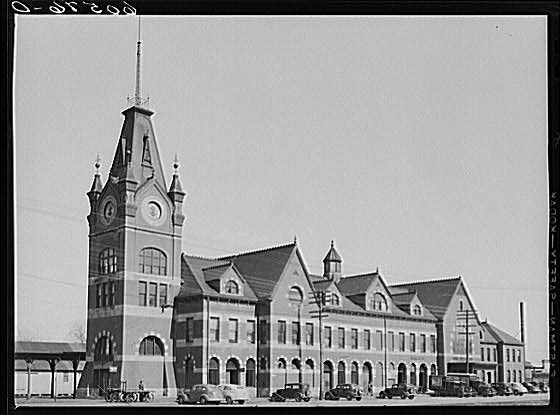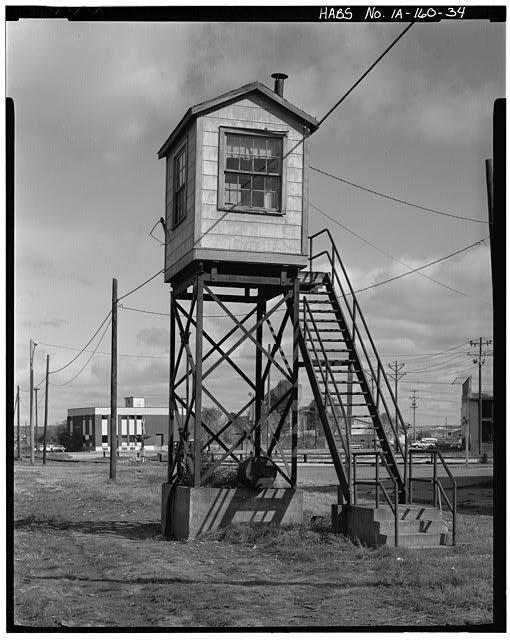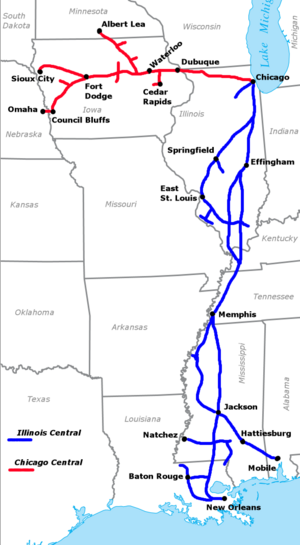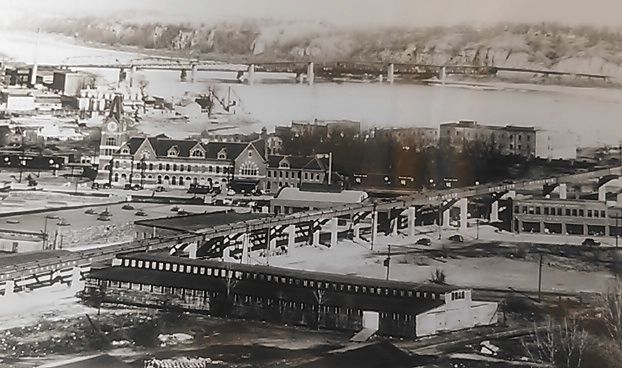Encyclopedia Dubuque
"Encyclopedia Dubuque is the online authority for all things Dubuque, written by the people who know the city best.”
Marshall Cohen—researcher and producer, CNN
Affiliated with the Local History Network of the State Historical Society of Iowa, and the Iowa Museum Association.
ILLINOIS CENTRAL RAILROAD: Difference between revisions
No edit summary |
No edit summary |
||
| Line 2: | Line 2: | ||
This entry is being edited. | This entry is being edited. | ||
[[Image:illc.png|left|thumb| | [[Image:illc.png|left|thumb|150px|]] | ||
In 1850, before the Illinois Central System's first | In 1850, before the Illinois Central System's first | ||
Revision as of 00:46, 18 October 2014
This entry is being edited.
In 1850, before the Illinois Central System's first
line was built in Iowa, only one of every 131 acres
of land in the counties later traversed by the rail-
road was under cultivation. Today one out of every
one and one-half acres is under cultivation. Where
there were fewer than 88,000 acres in crop land in
these counties in 1850, there are now more than
7,700,000 acres classified as crop land. (1)
In 1927, the Illinois Central Railroad was stretched over twenty-nine Iowa counties and included some of the oldest railway lines in the state. (2) The history of railroads in Iowa began with the passage on September 20, 1850 of the Illinois Central Land Grant Act by the United States Congress. (3) This laid the way for the passage of the Iowa Land Grant Act and the construction of the Illinois Central between Dubuque and Sioux City. In 1850 the twenty-nine counties that would be cross by the Illinois Central had less than 5,000 families with more than 3,000 of these contained in Dubuque and Linn counties. (4) Iowa senators George Wallace JONES and Augustus C. Dodge had added to the Illinois Central bill that the proposed railroad should have a branch line extending from its northern terminus at La Salle to Dubuque in the state of Iowa. (5) The Illinois Central was under construction in Illinois before the end of 1851.
Settlers streamed to Dubuque where Lucius Hart LANGWORTY, Jesse P. FARLEY began making plans for a railroad westward from Dubuque. Such an idea had been in the community for several years through the effort of John PLUMBE, Jr.. On April 28, 1853 a meeting was held for the purpose of organizing the DUBUQUE AND PACIFIC RAILROAD. (6)
In July 1855 the construction of the Illinois Central had reach Dunleith (now East Dubuque). In a grand celebration held on July 18, 1855 visitors from New York, Buffalo, Cleveland and Chicago listed with local residents to speeches from Stephen A. Douglas and George W. Jones. The number of arrival to Dubuque hotels in 1855 reached 85,045. (7) The Dubuque Land Office sold 1,610,363 acres of land. (8)
The financial difficulties of the Dubuque and Pacific Railroad led to it being forced into receivership by Morris K. Jesup. On August 13, 1860, the company was reorganized as the DUBUQUE AND SIOUX CITY RAILROAD. The company's first annual report for the year 1860 showed ownership of four locomotives, six passenger cars, sixty-five box cars, and thirty-five flat cars. (9)
While the Dubuque and Sioux City inched its way towards Cedar Falls, work had been started on the CEDAR FALLS AND MINNESOTA RAILROAD incorporated on April 16, 1858.
The Illinois Central Railroad (IC), sometimes called the "Main Line of Mid-America," had primary routes connecting Chicago, Illinois with New Orleans, Louisiana and Birmingham, Alabama. A line also connected Chicago with Sioux City, Iowa (1870). There was a significant branch to Omaha, Nebraska (1899) west of Fort Dodge, Iowa and another branch reaching Sioux Falls, South Dakota (1877) starting from Cherokee, Iowa.
The IC was one of the earlier Class I railroads in the US. Its roots stretch back to attempts by the Illinois General Assembly to charter a railroad linking the northern and southern parts of the state of Illinois. In 1850 U.S. President Millard Fillmore signed a land grant for the construction of the railroad, making the Illinois Central the first land-grant railroad in the United States. An amendment championed by Senator George Wallace JONES extended the line to Dubuque ensuring the future importance of the city.
The Illinois Central was officially chartered by the Illinois General Assembly on February 10, 1851. Upon its completion in 1856, the IC was the longest railroad in the world. Its main line went from Cairo, Illinois, at the southern tip of the state, to Galena, in the northwest corner. A branch line went from Centralia (named for the railroad) to the rapidly growing city of Chicago.

In 1867 the Illinois Central extended its track into Iowa. Throughout the 1870s, and 1880s the IC acquired and expanded railroads throughout the southern United States. IC lines crisscrossed the state of Mississippi and went as far as New Orleans, Louisiana to the south and Louisville, Kentucky in the east. In the 1880s, northern lines were built to Dodgeville, Wisconsin, Sioux Falls, South Dakota, and Omaha, Nebraska. Further expansion continued into the early twentieth century. In the 1950s and 1960s the Illinois Central provided passenger service through Dubuque aboard the "Land O' Corn" between Chicago and Waterloo and west to Sioux City aboard the "Hawkeye." (2)

The Canadian National Railway gained control of the IC in 1998, and it is now part of the CN Southern Region.
---
Source:
1. "Iowa and the Illinois Central," Illinois Central Magazine, Nov. 27, 1927, p. 13
1. Meyer, Jeffrey J. "Inter-century Railroad Stations," Julien's Journal, February 2012, p. 50
2. Meyer, Jeffrey J. "Clear the Track," Julien's Journal, March 2010, p. 36




